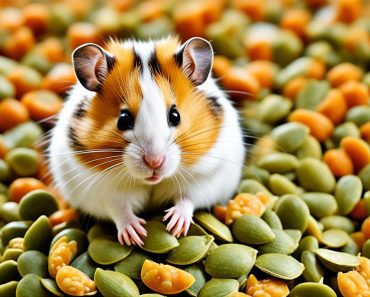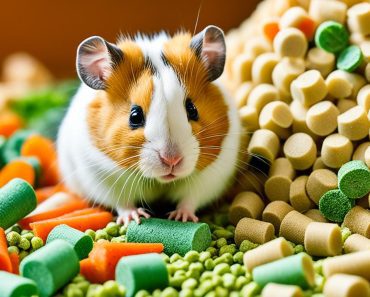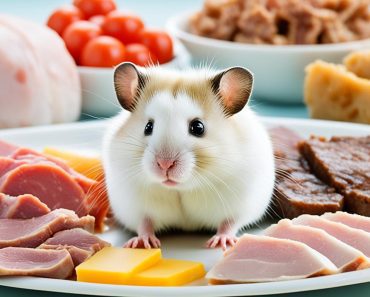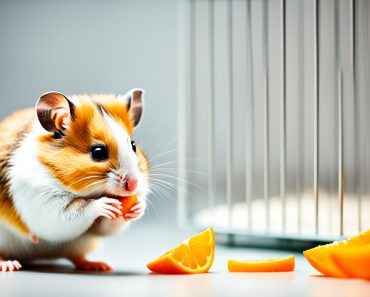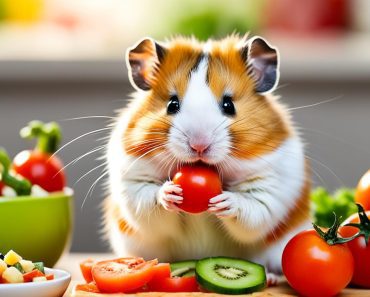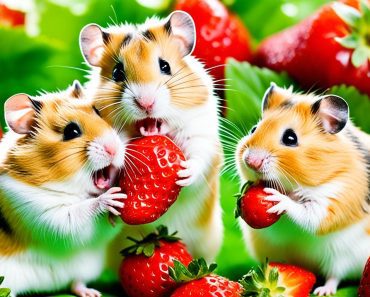Hey there! Are you a proud hamster owner wondering – can hamsters eat lettuce? Well, you’ve come to the right place. Let’s dive into the world of hamsters and lettuce to discover whether it’s a safe and healthy option for your little companion.
Lettuce, being a leafy green vegetable, can offer some nutritional benefits to our hamster friends. It is low in calories and has a high water content, which can help keep our hamsters hydrated. However, it’s important to note that lettuce should not be the main component of a hamster’s diet, as it lacks certain essential nutrients.
To ensure a well-balanced diet, it’s best to offer a variety of vegetables to your hamster. Lettuce should be given in moderation and thoroughly washed before being served. It’s also crucial to cut the lettuce into small, bite-sized pieces for easy consumption.
One more thing to keep in mind is to avoid feeding your hamster wilted or spoiled lettuce. These can cause digestive issues, and we certainly don’t want that for our little buddies! Additionally, it’s essential to monitor your hamster’s response to lettuce and discontinue feeding if any adverse reactions occur.
Can Hamsters Eat Lettuce? Yes, they can, once in a while.
- Lettuce can be given to hamsters in moderation and provides hydration due to its high water content.
- Lettuce should not be the main component of a hamster’s diet as it lacks certain essential nutrients.
- Always wash and cut lettuce into small, bite-sized pieces before feeding it to your hamster.
- Avoid feeding wilted or spoiled lettuce to prevent digestive issues.
- Monitor your hamster’s response to lettuce and discontinue feeding if any adverse reactions occur.
The Importance of a Balanced Diet for Hamsters
A balanced diet is crucial for the overall health and well-being of hamsters. As a responsible owner, it’s essential to ensure that your hamster receives optimum nutrition to support their growth and maintain their health.
When it comes to hamster nutrition, the best diet for hamsters consists of a combination of commercially produced pelleted rodent food and fresh vegetables. A high-quality pelleted rodent diet is specifically formulated to provide the necessary vitamins, minerals, and nutrients that hamsters need to thrive. Look for a brand that meets the nutritional requirements for your hamster’s specific breed.
However, it’s important to supplement the pelleted rodent food with a variety of fresh vegetables to ensure a well-rounded and balanced diet. Incorporating fresh vegetables into their diet provides additional vitamins and fiber.
It’s recommended to include vegetables such as carrots, squash, broccoli, cauliflower, and leafy greens like romaine lettuce and spinach. These vegetables are safe for hamsters and offer nutritional benefits that contribute to their overall well-being.
Fruits can also be added to their diet as occasional treats. However, it’s important to note that fruits should be given in moderation due to their higher sugar content. Suitable fruit options for hamsters include small pieces of apple (without seeds or skin), bananas, or raisins. Remember to cut the fruits into small, manageable pieces to prevent choking hazards.
The ideal hamster diet should consist of approximately 15-25% protein, 35-40% carbohydrates, 4-5% fat, and 5% crude fiber. These percentages ensure that your hamster receives the necessary nutrients to support their growth and maintain their overall health.
To ensure the best diet for your hamster, consult with a veterinarian who can provide personalized dietary recommendations based on your hamster’s size and health condition. They can help you determine the appropriate caloric intake and guide you on portion sizes for each food group.
Avoid relying solely on seed-based diets, as these can lead to nutritional deficiencies and health issues such as obesity and diabetes in hamsters. It is important to provide a well-balanced diet that includes both pelleted rodent food and fresh vegetables to meet all of your hamster’s nutritional needs.
Safe Vegetables for Hamsters
Hamsters can safely enjoy a variety of vegetables as part of their diet. Including these vegetables in their diet ensures they receive the necessary vitamins and minerals for optimal health. Here are some safe vegetables for your furry friend:
- Carrots: Carrots are a great source of vitamin A and provide a crunchy texture that hamsters love.
- Squash: Both summer and winter squash varieties, such as zucchini and butternut squash, are excellent options for hamsters.
- Broccoli: Broccoli offers a range of nutrients and makes a nutritious addition to your hamster’s diet.
- Cauliflower: Like broccoli, cauliflower is packed with nutrients and provides a delicious treat for hamsters.
- Cucumber: Cucumbers are hydrating and refreshing for hamsters, making them a suitable choice.
- Romaine Lettuce: This leafy green is safe for hamsters in moderation and can be given as a fresh snack.
- Spinach: Spinach contains several essential vitamins and minerals and can be served to hamsters in small quantities.
Remember to wash these vegetables thoroughly and cut them into small, easily manageable pieces. Introduce new vegetables gradually and in small amounts to prevent digestive upset in your little pet.
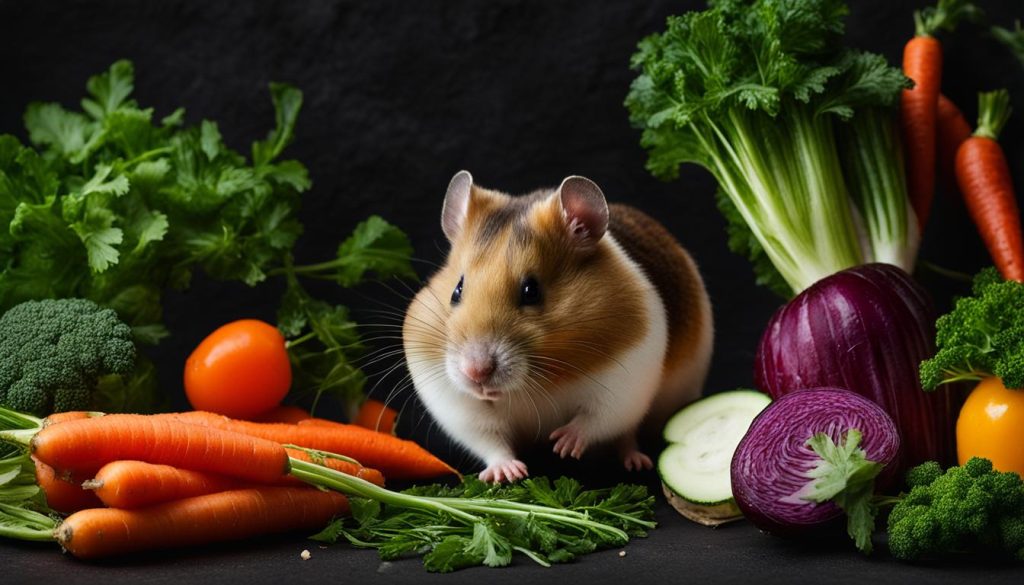
Hamster Treats and Moderation
While hamsters can enjoy a variety of human foods as treats, it is important to offer them in moderation. Treats should only make up a small portion of a hamster’s diet to ensure they receive the necessary nutrients from their main food source.
Some safe and healthy treats for hamsters include:
- Sugarless breakfast cereals or grains
- Seeds
- Carrots
- Apples (without seeds or skins)
- Raisins
- Peas
- Pepper
- Cucumbers
These treats should only be given occasionally and in small amounts since they tend to have a higher sugar content. It is important to remember that treats should not replace a hamster’s main diet, which should consist mostly of a well-balanced pelleted rodent diet. Feeding too many treats can lead to weight gain, dental problems, and other health issues.
It is also crucial to avoid giving dried fruits and vegetables to hamsters as they can be high in sugar and preservatives. Stick to fresh, natural treats to ensure the health and well-being of your furry friend.
Bedding and Cage Considerations
Choosing the right bedding for your hamster is crucial to ensure their comfort and safety. When it comes to hamster bedding, it’s best to avoid using cedar shavings. Cedar chips contain oils that can irritate your hamster’s skin. Opt for safe bedding options such as aspen or paper-based bedding, which provide a soft and cozy environment for your furry friend. Regularly changing your hamster’s bedding and cleaning their cage is important to maintain hygiene and prevent odors.
To keep your hamster entertained, provide them with plenty of toys and items to play with. They enjoy exploring paper towel tubes, plain brown boxes, and other chewable items. These not only keep them occupied but also help to wear down their constantly growing teeth.
When it comes to selecting a hamster cage, consider the size and type that would be most suitable for your pet. Hamsters need enough space to exercise and explore. Ensure that the cage has secure doors and latches to prevent any escape attempts. A cage with multiple levels or climbing structures can provide added enrichment for your hamster.
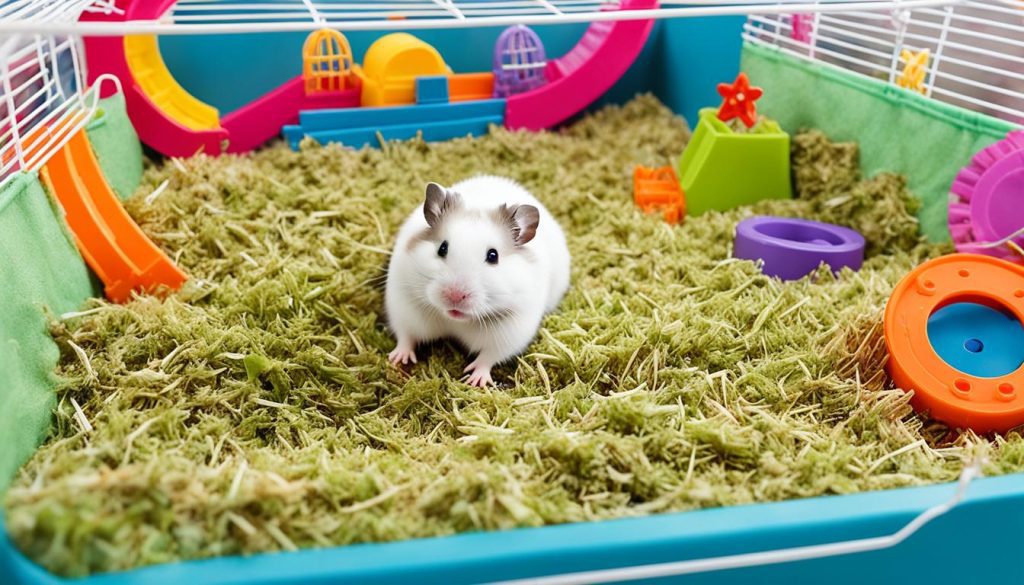
Dental Care for Hamsters
Hamsters have teeth that continuously grow, similar to fingernails. It’s crucial to provide them with proper dental care to prevent overgrowth and maintain their overall oral health.
One of the best ways to help hamsters maintain healthy teeth is by providing them with chew toys. Chew toys, such as paper towel tubes or wooden treats, give hamsters something hard to gnaw on, which helps wear down their teeth naturally. Dog biscuits can also be a good treat option for hamsters as they are hard and provide calcium while promoting short teeth.
If you notice any signs of difficulty eating or overgrown teeth, it’s essential to seek veterinary assistance. A veterinarian can perform professional teeth trimming to ensure your hamster’s teeth are maintained at a healthy length. They have the expertise and tools necessary to trim your hamster’s teeth safely and effectively.
By prioritizing dental care for your hamster, you can help prevent dental issues and ensure your furry friend’s overall well-being.
Creating a Safe Environment for Your Hamster
When it comes to the well-being of your hamster, creating a safe environment is essential. From the placement of the cage to providing opportunities for exercise, hamster safety should be a top priority. Here are some tips to ensure your hamster stays happy and healthy:
Hamster Cage Placement
When choosing a location for your hamster’s cage, it’s important to consider both their comfort and safety. Avoid placing the cage in direct sunlight or near a heater, as extreme temperatures can be harmful to hamsters. Additionally, avoid placing the cage in a dark, cold basement or an exposed area where it can be easily knocked over. Finding a well-ventilated area with moderate temperatures is ideal for your hamster’s well-being.
Hamster Exercise
Providing opportunities for exercise is crucial for keeping your hamster active and healthy. One essential item for hamsters is a running wheel, which allows them to engage in natural running behavior. A running wheel should be appropriately sized, providing enough space for your hamster to run comfortably. Additionally, consider offering climbing toys or accessories in the cage to encourage physical activity and mental stimulation.
Hamster Safety
Ensuring the safety of your hamster is vital. If you have a plastic cage, you may consider adding tubing additions to expand their living space. However, it’s essential to ensure that the cage is suitable for such additions and that there are no sharp edges that could harm your hamster.
Additionally, when allowing your hamster to exercise outside of the cage, consider using a hamster ball for supervised exploration. This allows your hamster to roam freely while preventing any potential dangers.
Conclusion
Proper care and nutrition are essential for keeping your hamster healthy and happy. By providing a well-balanced diet, including a mix of pelleted rodent food, fresh vegetables, and occasional treats, you can ensure your hamster receives the necessary nutrients.
Pay attention to the type of bedding you use and regularly clean your hamster’s cage to maintain cleanliness and prevent odors. Offer your hamster plenty of opportunities for exercise and mental stimulation, with toys and a suitable living environment. Regularly monitor your hamster’s dental health and seek veterinary assistance if any issues arise.
By following these tips, you can provide optimal care for your hamster and promote their overall well-being.

